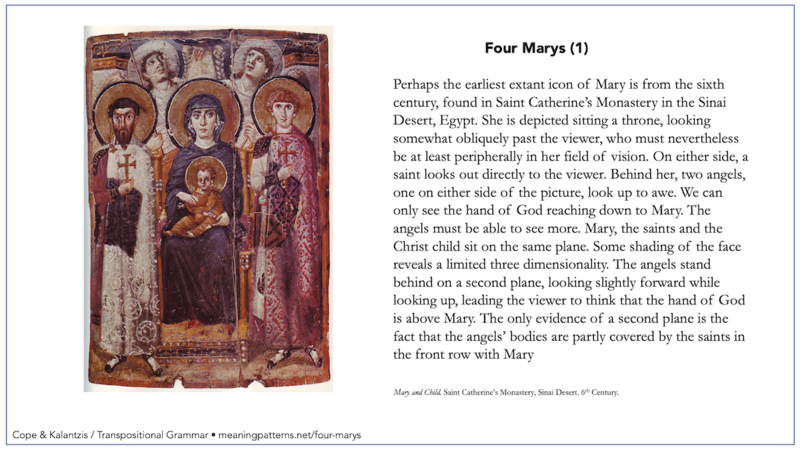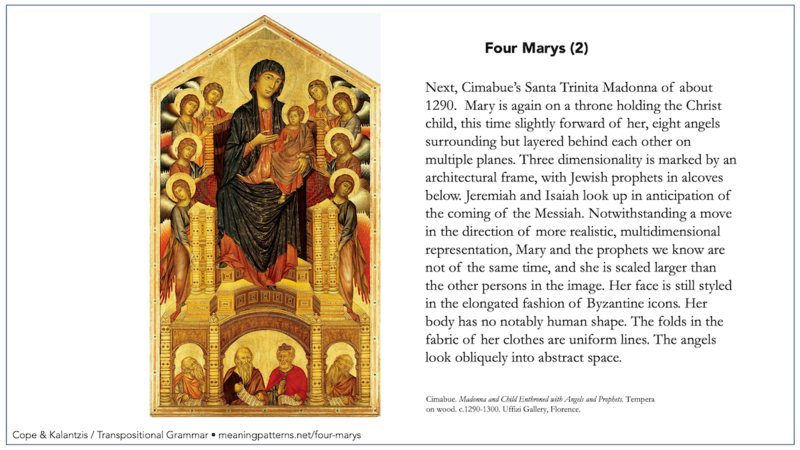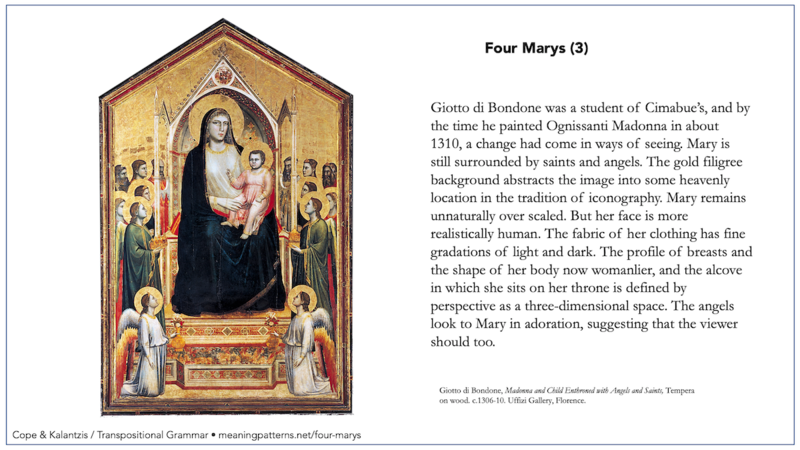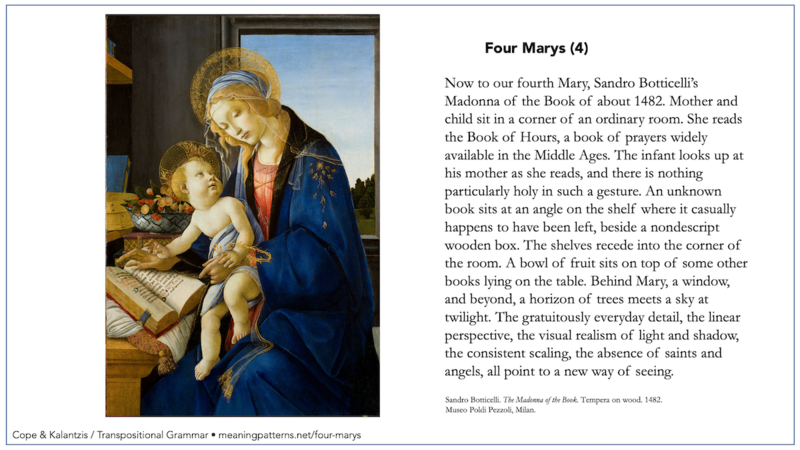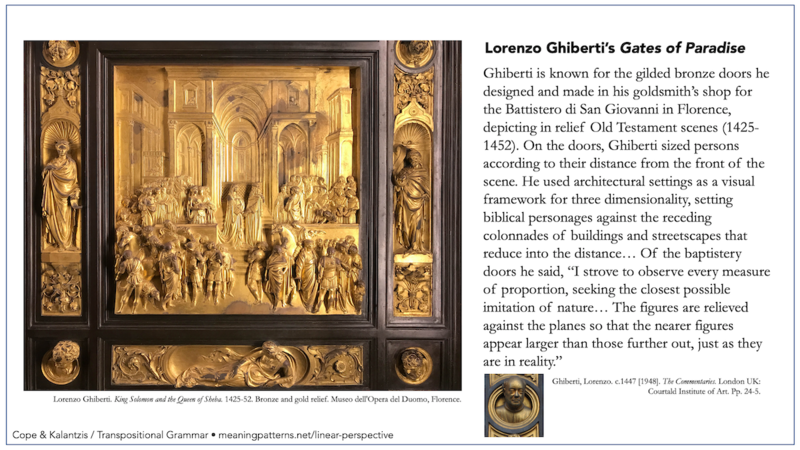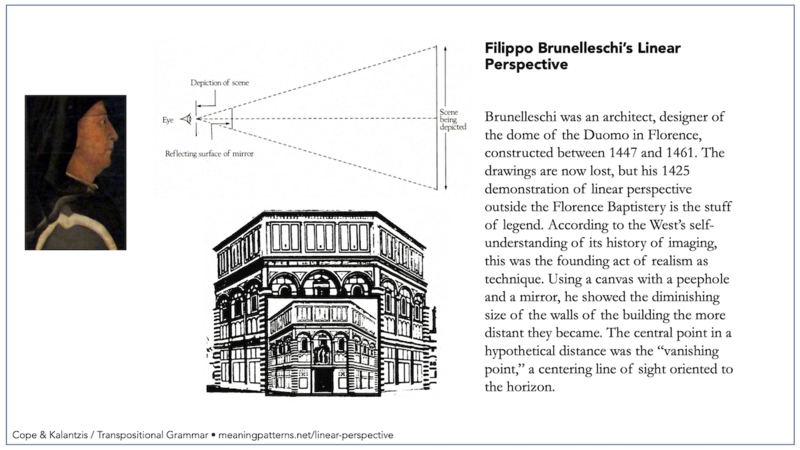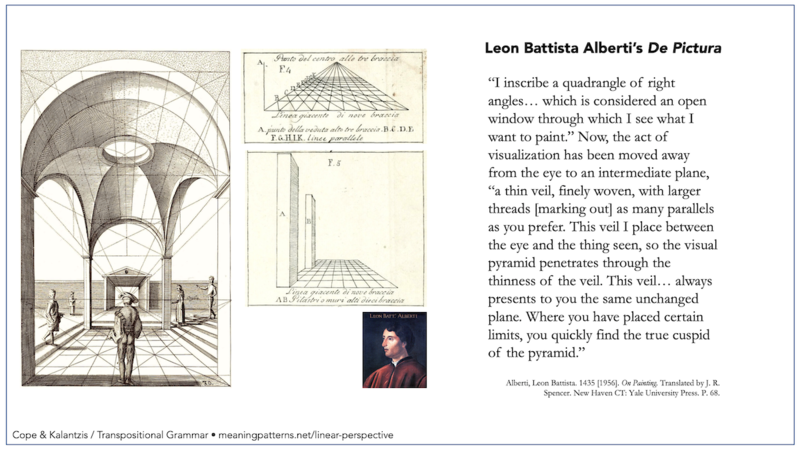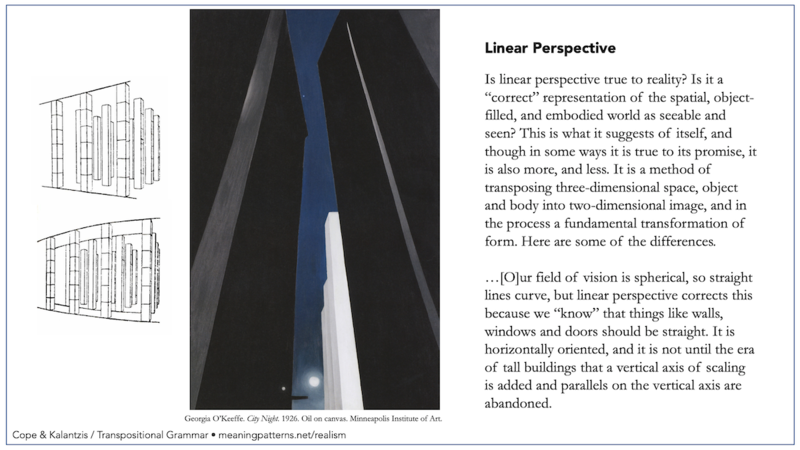Meaning Patterns’s Updates
Ways of Seeing: "Realism" as a Visual Trick of Transposition
“Alone of all her sex”123 she was, Mary mother of Christ, the sole virgin mother, impossible except for God. So she was declared to be by the Council of Ephesus in 431, not mere Χριστοτόκος or “Christ-bearer,” because that would be to diminish the divinity of Christ, but Θεοτόκος or “God-Bearer.” “Therefore, because the holy virgin bore in the flesh God who was united hypostatically with the flesh, we call her the mother of God.”124 Though not a substantial figure in the gospels, from this time Mary became on object of holy adoration in her own right, a centrally placed holy “she” in a theological narrative otherwise dominated by men.
A sequence of four images spanning nearly a thousand years of Mary-worship speaks to the evolution of ways of seeing the mother of Christ and, with her, the imaged world.
Perhaps the earliest extant icon of Mary is from the sixth century, found in Saint Catherine’s Monastery in the Sinai Desert, Egypt. She is depicted sitting on a throne, looking somewhat obliquely past the viewer, who must nevertheless be at least peripherally in her field of vision. On either side, a saint looks out directly to the viewer. Behind her, two angels, one on either side of the picture, look up in awe. We can only see the hand of God reaching down to Mary. The angels must be able to see more. Mary, the saints, and the Christ child sit on the same plane. Some shading of the face reveals a limited three-dimensionality. The angels stand behind on a second plane, looking slightly forward while looking up, leading the viewer to think that the hand of God is above Mary. The only evidence of a second plane is the fact that the angels’ bodies are partly covered by the saints in the front row with Mary.
Next, Cimabue’s Santa Trinita Madonna of about 1290.125 Mary is again on a throne holding the Christ child, this time slightly forward of her, eight angels surrounding but layered behind each other on multiple planes. Three-dimensionality is marked by an architectural frame, with Jewish prophets in alcoves below. Jeremiah and Isaiah look up in anticipation of the coming of the Messiah. Notwithstanding a move in the direction of more realistic, multidimensional representation, Mary and the prophets we know are not of the same time, and she is scaled larger than the other persons in the image. Her face is still styled in the elongated fashion of Byzantine icons. Her body has no notably human shape. The folds in the fabric of her clothes are uniform lines. The angels look obliquely into abstract space.
Giotto di Bondone was a student of Cimabue’s, and by the time he painted Ognissanti Madonna in about 1310, a change had come in ways of seeing. Mary is still surrounded by saints and angels. The gold filigree background abstracts the image into some heavenly location in the tradition of iconography. Mary remains unnaturally over-scaled. But her face is more realistically human. The fabric of her clothing has fine gradations of light and dark. The profile of breasts can be seen and the shape of her body is now womanlier, and the alcove in which she sits on her throne is defined by perspective as a three-dimensional space. The angels look to Mary in adoration, suggesting that the viewer should too. Renaissance art and architecture theorist Lorenzo Ghiberti§2.2b writes about this painting in the next century, noting its pivotal place in the evolution of linear perspective.126 So does art historian Vasari in the century after that, also using the image to exemplify progress towards the realism of the greats, Leonardo and Michelangelo.127 Dante says, “Once Cimabue was thought to hold the field/In painting; now it is Giotto’s turn/The other’s fame lies buried in the dust.”128
Now to our fourth Mary, Sandro Botticelli’s Madonna of the Book of about 1482.129 Mother and child sit in a corner of an ordinary room. She reads the Book of Hours, a book of prayers widely available in the Middle Ages. The infant looks up at his mother as she reads, and there is nothing particularly holy in such a gesture. An unknown book sits at an angle on the shelf where it casually happens to have been left, beside a nondescript wooden box. The shelves recede into the corner of the room. A bowl of fruit sits on top of some other books lying on the table. Behind Mary, a window, and beyond, a horizon of trees meets a sky at twilight. The gratuitously everyday detail, the linear perspective, the visual realism of light and shadow, the consistent scaling, the absence of saints and angels, all point to a new way of seeing. Though elements of the old supernaturalism remain: the gold filigree halos, the child holding three gold nails of the cross and wearing the crown of thorns as a bracelet – these refer to a later part of the Christ child’s life only knowable by the viewer. This is how we know that the “she” of the image is the singularly holy Mary.§2.2b
***
While the painters were transforming their visual practices, three Florentine thinkers were developing a new theory of seeing – goldsmith and sculptor Lorenzo Ghiberti (1378–1455), architect Filippo Brunelleschi (1337–1446), and priest, architect, artist, and thinker Leon Battista Alberti (1404–1472).
Ghiberti is known for the gilded bronze doors he designed and made in his goldsmith’s shop for the Battistero di San Giovanni in Florence, depicting in relief Old Testament scenes (1425–1452).130 On the doors, Ghiberti sized persons according to their distance from the front of the scene. He used architectural settings as a visual framework for three-dimensionality, placing biblical personages against the receding colonnades of buildings and streetscapes that reduce into the distance. For their visual brilliance, Michelangelo called these doors The Gates of Paradise. Ghilberti theorized his art and the art of others in his Commentarii. Of the baptistery doors he said, “I strove to observe every measure of proportion, seeking the closest possible imitation of nature … The figures are relieved against the planes so that the nearer figures appear larger than those further out, just as they are in reality.”131
Brunelleschi was an architect, designer of the dome of the Duomo in Florence, constructed between 1447 and 1461. The drawings are now lost, but his 1425 demonstration of linear perspective outside the Florence Baptistery is the stuff of legend. According to the West’s self-understanding of its history of imaging, this was the founding moment of realism as technique. Using a canvas with a peephole and a mirror, he showed the diminishing size of the walls of the building the more distant they became. The central point in a hypothetical distance was the “vanishing point,” a centering line of sight oriented to the horizon. The relative sizes of seen objects could be figured mathematically.132 Concluded his fellow architect and biographer, Antonio Manetti, this was a crucial contribution to the science of perspective, “setting down properly and rationally the reductions and enlargements of near and distant objects as perceived by the eye.”133
Another architect, Alberti, was the first to theorize the new art and science of imaging in his De Pictura of 1435. Imagine a series of visual rays running from the eye to the objects it sees, he says. “Among these visual rays there is one which is called the centric.” This ray points in the direction of what we know to be the vanishing point of linear perspective. Surrounding this ray, a “visual pyramid” can be conceived, around which objects are arranged “in a definite place in respect to the observer.” Then, to draw, “I inscribe a quadrangle of right angles … which is considered an open window through which I see what I want to paint.” Now, the act of visualization has been moved away from the eye to an intermediate plane, “a thin veil, finely woven, with larger threads [marking out] as many parallels as you prefer. This veil I place between the eye and the thing seen, so the visual pyramid penetrates through the thinness of the veil. This veil … always presents to you the same unchanged plane. Where you have placed certain limits, you quickly find the true cuspid of the pyramid.”
The result is both naturalism and supernaturalism. Naturalism: “the studious painter will know from nature, and he will … be wide awake with his eyes and mind in this investigation and work … discovering and learning beauty.” And still, supernaturalism: “Painting contains a divine force which not only makes absent men present, [and] the dead seem almost alive … [P]ainting is most useful to that piety which joins us to the gods and keeps our souls full of religion.”134
***
To transpose three-dimensional spaces, objects, and bodies onto a two-dimensional plane – this is one of the moves that we need to trace in a grammar of multimodality. Linear perspective, it would seem, is an act of realism, a mathematical/scientific discovery of the early modern West: to reference things accurately in image in such a way that the image truthfully captures the empirical world for the way it in fact looks.135
No, says Erwin Panofsky, this is a “symbolic form,” a peculiarly Western way of seeing and thus thinking that was invented by artists and theorists of optics in the European Renaissance.136 No, says Norman Bryson too, this is a characteristically Western form of “the gaze,” an historically and culturally specific way of seeing, a mode of symbolic representation, as distinct from intrinsic being-in-the-world.137
We want to frame the human artifice that underlies naturalism in somewhat different terms. We do not want to offer a different or privileged place for symbolization, a term commonly used to classify what may be considered as second-order, abstracting, cognitively constructed systems and practices of representation such as writing and imaging.§AS1.1.3a In such a conventional view, our primary engagements in and with space, object, and body are viscerally experiential and in this sense non-symbolic. Symbols reference these experiential meanings, as well as systematically referencing each other. Symbols in this view are meanings-of, as distinct from meanings-in.
Instead, we want to argue that meaning by image or text is of the same order as meaning by object and space and body. No distinction should be made between meanings-of and meanings-in. We don’t want to distinguish what might be considered symbolic from non-symbolic meaning. Besides, of symbols, Marshall McLuhan famously said, “the medium is the message”;138 meaning-in is meaning-of. Conversely, spaces, objects, and bodies are just as able as text and image to “stand for” singular or generalizable meanings, if that’s what we take symbolization to mean. Again, meaning-in is meaning-of.
So, if we dethrone symbolization from its privileged place, what we experience in the meaning practices of multimodality is a series of transpositions between forms of meaning, shunting backwards and forwards, meaning taking one form then another, each form with its own affordances. We are always shunting because the affordances of each form not only offer new opportunities to mean; their forms also circumscribe those meanings. This is why we constantly find a need to call upon multimodal supplementation.
To address now the affordances of image, is linear perspective true to reality? Is it a “correct” representation of the spatial, object-filled, and embodied world as seeable and seen? This is what it suggests of itself, and though in some ways it is true to its promise, it is also more, and less. It is a method of transposing three-dimensional space, object, and body into two-dimensional image, and in the process a fundamental transformation of form. Here are some of the differences.
Linear perspective is the line of sight of a single eye, but we are binocular creatures. Since stereoscopic photographs, we have known that a three-dimensionality can be captured more than linear perspective on a single plane allows. Then there is the fact that our field of vision is spherical, so straight lines curve, but linear perspective corrects this because we “know” that things like walls, windows, and doors should be straight.139 It is horizontally oriented, and it is not until the era of tall buildings that a vertical axis of scaling is added and parallels on the vertical axis are abandoned.140
As for the objectivity of the image, this is only deceptively the case, because we are by fiat of the artist’s selection placed where they want us to be, most of the time conventionally at the height of an adult person, looking towards an horizon. We see through the picturer and for the picturer what they have chosen us to see. What seems to be an objective representation is in fact a deeply intersubjective transposition of the artist’s eye with the viewer’s.141 The body is central – the body of the artist and the body of the viewer; but the body itself has disappeared in the seeing. This produces an in-body experience that is also weirdly out-of-body.
Or rather, we are led to believe that the body is central in viewing the picture (and centrally invisible), for even this is an optical illusion. As Alberti so insightfully points out, the image is not in the place of the eye of the artist or the viewer. Rather it is created on a visual plane between the artist and the world, and between the viewer and the world the viewer is seeing through the work of the artist. This plane is literally framed, edges defined to include chosen spaces, bodies, and objects and exclude absent others. It is composed, with pictured things arranged across a series of layers receding to a vanishing point on the horizon.142
For all the apparent anthropomorphism in viewing positions, the image itself is not located at the point of the eye, but on a plane placed between the eye of the artist or viewer, and the scene they are “seeing.” Alberti’s veil metaphor§2.2b is a nice one, because the image plane conceals as much as it reveals. Feigned naturalism conceals artifice. Ostensible objectivity conceals the subjectivities of the representing artist and the interpreting viewer; viewing occurs not at the eye but an intervening plane removed from the eye. Deeply architected, this plane is more like a window than an eye, based perhaps in habits of mind that became ubiquitous after the invention of glass window panes.
And another difference: the image is constituted both in its carefully considered making and in its at least half-careful viewing. This is “the gaze,” sustained looking that configures in systematic arrangement what is seen by artist or viewer. Gaze is quite different from seeing, which is a series of glances or “saccades,” as the eye jumps across three-dimensional spaces, objects, and bodies. When seeing images that have transposed three-dimensional things into a two-dimensional plane, the eye jumps from the most prominent things and the vanishing point to which it is directed, to less prominent and peripheral things. The image is fundamentally different from seeing, and seeing an image is fundamentally different from seeing the world. The image ties a hypothetical, all-seeing eye to a fixed point, while in viewing reality the eye constantly darts around, every which way.
Apparent naturalism also achieves its effects by lighting scenes artificially. How could Botticelli’s Madonna§2.2a be so perfectly lit? More likely in ordinary experience, mother and child would be dark figures against the natural light coming through the window, and if not, the outside world would be over-exposed. Our eyes adjust for differences in the intensity of light within a scene – this is another aspect of three-dimensional seeing, something that cannot happen in two-dimensional seeing.
And the presence of gratuitous detail: the book leaning at an angle on the shelf and the fruit bowl are unnecessary to picturing of virgin and son, except that their irrelevance speaks to the realism of the scene. They are things you might see and wonder about only upon careful looking. Might they symbolize something? Perhaps, but not as obviously as the sacred meaning of Madonna and child. We see the book and the bowl in a kind of peripheral vision. There, they speak more to realism of the focal bodies than any intrinsic meaning in these things.
Finally, of style: in their regularized artificiality, Byzantine icons§2.2a show manifest style, a consistently applied lack of realism that distinguishes them as holy reference. Chinese landscape paintings, with their stylized brushstrokes and unrealistic arrangement of trees and peaks, speak to the presence of the artist and their work with the medium.143 Realism attempts to hide its style, to speak truth to the visual powers of nature – and, as Alberti said, God as well, if He is nature’s meaning.
By these means, the three-dimensional world is distanced through an optical illusion, though the distance is by the artifice of image removed, transposed onto a two-dimensional plane where there is in fact no distance. This is how the world of depth is made virtual, and the virtual is a story that can only seem to be true. The world is laid out here to see on the image plane, but what it is showing is not there.
Realism is in these ways a technique of illusion, a series of tricks and tropes for the transposition of three-dimensional meanings to two. Its picturing, notwithstanding its disavowal of style, is itself a style, and more. It is a series of trompe l’oeil, manipulations, deceptions even, by means of which you are led to think the real has been represented. As it has, but also not.
- Cope, Bill and Mary Kalantzis, 2020, Making Sense: Reference, Agency and Structure in a Grammar of Multimodal Meaning, Cambridge UK: Cambridge University Press, pp.215-22 [§ markers are cross-references to other sections in this book and the companion volume (AS); footnotes are in this book.]
